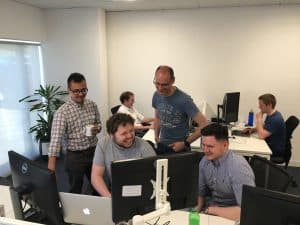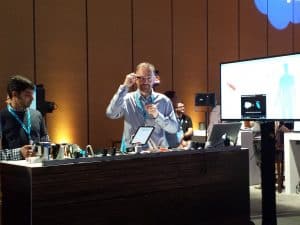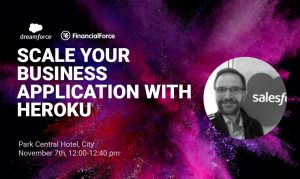Employee Spotlight: Stephen Willcock chats development innovation, the Salesforce platform, and having his dream job
Welcome to the Certinia Employee Spotlight Series! Here we highlight the many employees that help drive success of the company – across departments, offices, and the globe. These are the faces of Certinia.
In this edition, we speak with Stephen Willcock, Director of Product Innovation, based in our Harrogate, UK office, to learn more about what life is like designing, developing, and architecting applications on the Salesforce platform, his 9+ years at Certinia, and how he keeps product innovation in high gear.
Your current role is Director of Product Innovation, which sounds exciting – what are you responsible for in this role?
It’s genuinely a dream job. I have a small team of extraordinary developers, and we get to build prototypes for new products or product features, experimenting with the very latest Salesforce technologies. The work is varied; we might be presented with a tricky problem to solve or given a new technology or feature to evaluate and come up with ideas on how we can put them to best use in our cloud ERP products. The ultimate goal is to ensure that we find every way to maximize the Salesforce platform (and other complementary technologies) to solve business challenges for our customers.
What do you enjoy most about the role?

What are some challenges in a role like this?
The challenges really come from a point mentioned above: applying the right level of control over projects. Our research projects work well when developers are given greater freedom to be creative, but too much freedom and projects can lose focus. From the developer’s perspective too, I think that this balance has a significant impact on work satisfaction.
How do you find working with the Salesforce platform?
The Salesforce Lightning Platform is an amazing environment for building cloud applications. We see three releases a year, delivering new features for end-users and developers alike. It’s not without its challenges of course. The platform is multi-tenant, and the model Salesforce uses to ensure consistent performance for all users can feel like a lot to manage at first, especially for new developers. The benefits heavily outweigh the challenges though!
What would you say to developers who come from a more mainstream background (e.g. in Java or C#), and what moving to Salesforce would mean for their career?

What are the key advantages of the Salesforce platform?
Building on the Salesforce platform means that your work immediately benefits from the security, resilience, and backup that lives in the very fabric of the platform. There is also a huge array of functionality built in that gives you a flying start on any project – database, user interface, APIs, reporting, workflow, social and mobile features. And finally, your applications are inherently customizable and extensible because that’s the way the platform was designed. It’s interesting to find that developers new to Salesforce have to be trained to do less and let the platform do the work.
Certinia has grown a lot, and you’ve been here from the beginning. What is it like working for a company that has gone through hyper-growth?
It’s been an incredible and worthwhile roller coaster ride so far! I’ve needed to adapt at various stages of growth. For example, in the early days, part of the attraction was the small, tight-knit team, where the boundaries between roles were in some ways less distinct. A developer might have been pulled into a pre-sales call, or someone in marketing might be called upon to do some additional software testing. Today we’ve retained that spirit – being “one team” is in our corporate DNA – but we’re now more focused on specialties, and therefore able to develop skills in a more concentrated way.
With the company growth and product-driven goals, there must be a natural pressure for constant innovation – how do you keep up?
It’s the tremendous growth that has allowed us to put together a team dedicated to technology research, and we’re certainly kept busy! The company is filled with very smart people – there’s no shortage of ideas, and the Salesforce platform is evolving very quickly, continually opening opportunities for us to exploit. So, yes – busy but rewarding!

What innovation have you developed that you’re most proud of and that you’ve seen have a big impact at Certinia?
I have really enjoyed working with Salesforce Einstein Analytics and watching this technology start to mature over the last couple of years. It’s also been great to see some of our feedback incorporated into that platform. Einstein is also now making its way into our own products which is very exciting. Heroku was probably the strongest theme for us last year, and we were proud to be able to share much of that work with the developer community at https://orizuru.github.io.
What advantages does Certinia have over its more traditional competitors?
From the start, partnering with Salesforce allowed us to punch above our weight. All of the advantages of the platform that we talked about before, these get rolled into our products, and that’s a significant plus. In terms of our own operations, we gain the benefits of SaaS and being on Salesforce (just like our customers) where all of our data is in one place and unified even across multiple application vendors. We can report across all our data and develop automated processes over a single database.
Can you switch off after hours or are you constantly trying to think of new ideas?
I absolutely switch off after hours. I think that’s very important in order to stay fresh. It’s often when you stop looking that ideas and solutions start to flow, so I do tend to jot down thoughts at all hours. I’m a bit of a super techie so there’s also a lot of tech play outside of the office that indirectly feeds into work.

When you are not in the office, how do you like to spend your downtime?
I took up running a few years ago – it started off being something I felt I needed rather than wanted to do, but now I’m totally addicted, I can’t get enough. I’m not going to break any records, but running is a great way to clear my head and set me up for the day. I’ve run my first marathon, which I really couldn’t have imagined when I started!
What is your favorite tech gadget and why?
It’s hard to beat my Garmin running watch. It gives me more stats than I know what to do with, and I always get a buzz seeing my run uploaded and synced with a bunch of running sites before I’ve even cooled down.





